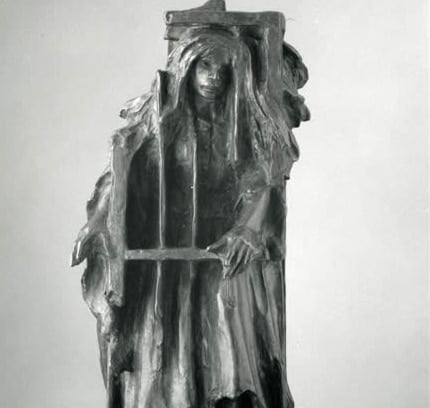Family Stories Collection: This special collection contains a selection of family history stories submitted by our readers. Originally published April 2, 2014.
“La Corriveau”… Her real name was Marie-Josephte Corriveau, and she was one of the most infamous murderers in Canadian history. She was born in 1733 near Quebec, and she is my husband’s 2nd cousin, 6 times removed. This is a bronze sculpture of her from the National Museum of Fine Arts of Quebec.
According to the Dictionary of Canadian Biography Online, she was born in 1733 in Quebec and married in 1749 to Charles Bouchard, by whom she had three children. After he died in 1760, she married again, in 1761, to Louis Didier. Not long afterwards, in 1763, her husband Louis’ body was found in the stable, with several fatal blows to the head. Neighbors and family found it hard to believe that the horse was the culprit, and suspicion soon fell on Marie-Josephte.
There were two sensational trials. The first ended with a death sentence by hanging—for Marie’s father!—who had confessed to the crime to save his daughter. (Marie was sentenced to be flogged and branded for her part in it.) But before these sentences could be carried out, her father made his last confession to a priest—and revealed his daughter as the sole murderer. (He was later pardoned by England’s King George III.)

Photo : MNBAQ, Patrick Altman (1934.427)
At the second trial Marie confessed; she had struck her husband twice with an axe while he was sleeping and dragged his body to the stable. She was sentenced to death by hanging—with the stipulation that after being executed, her body would be put in an iron cage made in the shape of a human body, and displayed publicly as an example. The creaking of the cage inspired ghost stories to spring up around her, and as time went by, the legend grew. (One author, T.W. Denomme in Our French Canadian Ancestry in Huron County, said she may have murdered her first husband also, by pouring hot molten lead in his ear while he was asleep!) After more than a month of this gruesome public display, her body (and the cage) were buried in the grounds outside the Catholic cemetery in Lauzon—since no one such as her could be buried within the holy grounds of the cemetery.
The cage and few bones were rediscovered by a gravedigger in 1850, by which time the cemetery had been enlarged, and the myths surrounding her took on new life. Denomme’s book says that he cage went on display at the Barnum Museum in New York City and was later lost in a fire there. Marie-Josephte has been an object of interest ever since, with art, film, music, and entire chapters of books being devoted to her, and she is still known as “La Corriveau.”

Yes, they are positive. Thanks. I like them.
Sometimes they are!
But try these posts also (all posted on Family History Daily): “The Fourteen Garvers of Clare County, Michigan” and “Double Wedding Ring” and also “Grandma Wallin: Ahead of Her Time.”
swm :-]
Mary Wallin Mosey’s articles are always so sad.
Pingback: "La Corriveau" - Second Cousin and In...